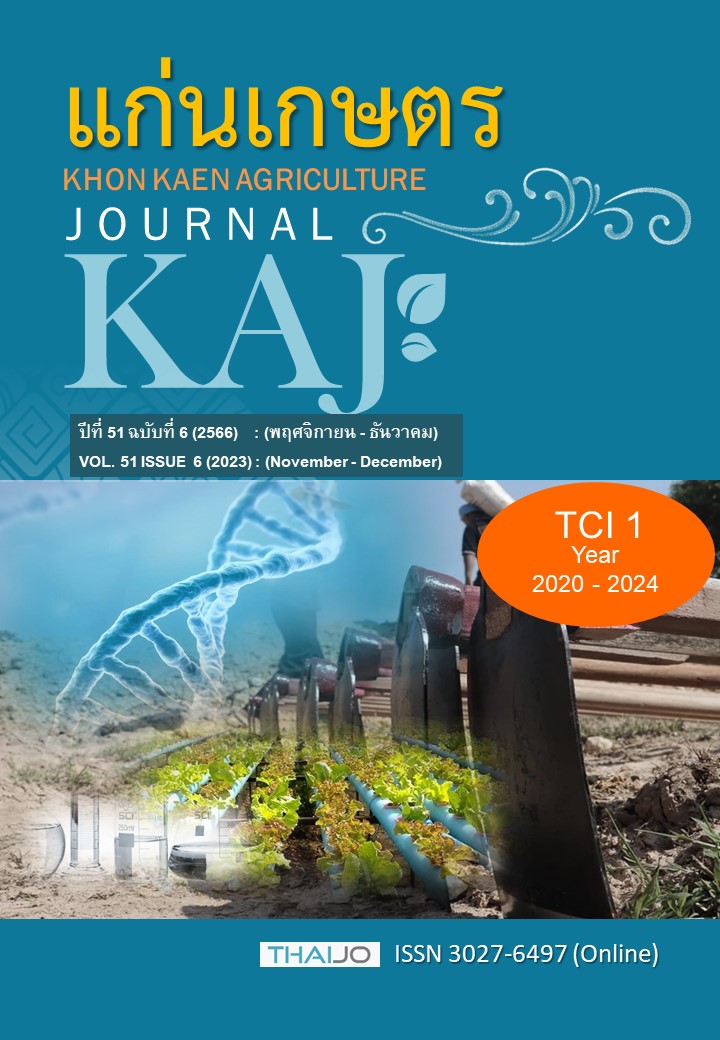ผลของพืชไม้ดอกไม้ประดับต่อชีววิทยาของยุงลายสวน Aedes albopictus
Main Article Content
บทคัดย่อ
ยุงลายสวน Aedes albopictus เป็นแมลงพาหะที่มีศักยภาพในการนำโรคติดต่อหลายชนิดในมนุษย์ เช่น ไข้เลือดออก ไข้เหลือง ไข้ปวดข้อยุงลาย และไข้สมองอักเสบ งานวิจัยนี้มีวัตถุประสงค์เพื่อศึกษาผลของปัจจัยทางชีวภาพ เช่น ชนิดของพืชอาศัย ต่อชีววิทยาและการดำรงอยู่ของประชากรยุงลายสวนในสภาพห้องทดลอง พืชที่ใช้ในการทดลองจำแนกได้เป็น 2 กลุ่ม คือ พืชโครงสร้างกักเก็บน้ำได้ (Structural plants) จำนวน 7 ชนิด ได้แก่ ว่านหางจระเข้ ลิ้นมังกร สับปะรดสี กล้วยไม้ หัวใจสีม่วง ช้อนเงินช้อนทอง และรวยไม่เลิก และพืชที่อาศัยอยู่ในน้ำ (Aquatic plants) จำนวน 4 ชนิด ได้แก่ กกราชินี บัว พลูด่าง และไผ่กวนอิม จากการทดสอบหาอัตราการวางไข่และอัตราการรอดชีวิตของยุงลายสวนที่เลี้ยงในพืชไม้ประดับในครัวเรือน พบว่ายุงลายสวนมีอัตราการวางไข่และอัตราการฟักของไข่สูงที่สุดในสับปะรดสี (ในกลุ่มพืชที่มีโครงสร้างกักเก็บน้ำ) มีค่าเท่ากับ 69.6 ฟอง และร้อยละ 63.2 ตามลำดับ และบัว (ในกลุ่มพืชที่อาศัยอยู่ในน้ำ) มีค่าเท่ากับ 82.2 ฟอง และร้อยละ 76.8 ตามลำดับ อัตราการรอดชีวิตของยุงลายสวนที่เลี้ยงในพืชไม้ประดับในครัวเรือน พบว่ายุงลายสวนเพศผู้และเพศเมียมีอัตราการรอดชีวิตสูงที่สุดในว่านหางจระเข้ (ในกลุ่มพืชที่มีโครงสร้างกักเก็บน้ำ) มีค่าเท่ากับ 4.4 และ 5.8 วัน ตามลำดับ และไผ่กวนอิม (ในกลุ่มพืชที่อาศัยอยู่ในน้ำ) มีค่าเท่ากับ 15.4 และ 21.4 วัน ตามลำดับ จากนั้นได้คัดเลือกไผ่กวนอิมและว่านหางจระเข้ เพื่อศึกษาตารางชีวิตของยุงลายสวนที่เจริญเติบโตในพืชทั้งสองชนิดดังกล่าว ผลการศึกษาพบว่าอัตราการขยายพันธุ์สุทธิ (R0) และอัตราการเพิ่มที่แท้จริง (rm) ของยุงลายสวนที่เจริญเติบโตในไผ่กวนอิม (ในกลุ่มพืชที่อาศัยอยู่ในน้ำ) มีค่าเท่ากับ 50.8 และ 0.3 ตามลำดับ และในว่านหางจระเข้ (ในกลุ่มพืชที่มีโครงสร้างกักเก็บน้ำ) มีค่าเท่ากับ 40.7 และ 0.29 ตามลำดับ เมื่อเปรียบเทียบกับผลการศึกษาที่ผ่านมา พบว่ายุงลายสวนที่เจริญเติบโตในไผ่กวนอิมและว่านหางจระเข้สามารถช่วยเพิ่มศักยภาพในการเพิ่มขยายประชากรยุงลายสวนได้มากขึ้น การศึกษาในครั้งนี้ทำให้ทราบว่าปัจจัยทางชีวภาพ เช่น ชนิดของพืชอาศัย มีผลต่อการดำรงอยู่ของยุงลายสวน ดังนั้นถ้าเราสามารถควบคุมปัจจัยทางชีวภาพดังกล่าวนี้ได้ ก็จะสามารถช่วยควบคุมการดำรงอยู่ของประชากรยุงลายสวนได้อีกด้วย
Article Details

อนุญาตภายใต้เงื่อนไข Creative Commons Attribution-NonCommercial-NoDerivatives 4.0 International License.
เอกสารอ้างอิง
Cleman, A.N. 2000. The biology of mosquito: development, nutrition and reproduction. 2nd ed. Vol. 1 CABI Publishing, London, United Kingdom.
Cui, G., S. Zhong, T. Zheng, Z. Li, X. Zhang, C. Li, E. Hemming-Schroeder, G. Zhou, and Y. Li. 2021. Aedes albopictus life table: environment, food, and age dependence survivorship and reproduction in a tropical area. Parasites Vectors. 14: 568.
Estrada-Franco, J.G., and G.B. Craig. 1995. Biology, disease relationships and control of Aedes albopictus. Washington D.C.: Pan American Health Organization.
Hans, J.O. 2007. Effect of plant structure on ovipostition behavior of Anopheles minimus s.l. Journal of Vector Ecology. 32(2):193-197.
Ho, B.C., K.L. Chan, and Y.C. Chan. 1972. III. Control of Aedes vector. The biology and bionomic of Aedes albopictus (Skuse). In: Y. C. Chan al. (eds.). Vector Control in South Asia. Proceeding 1st SEAMEO Workshop, 15-17 August 1972, Singapore.
Hong, K., J.C. Shin, and Y. Young. 1971. Hibernation studies of forest mosquitoes in Korea. Journal of Entomology. 1: 13-16.
Lounibos, L.P. 2002. Invasions by insect vectors of human disease. Annual Review of Entomology. 47:233-266.
Mahmood, F. 1997. Life table attributes of Anopheles albimanus (Weidemann) under controlled laboratory conditions. Journal of Vector Ecology. 22: 103-108.
Maimusa, H.A., A.H. Ahmad, N.F.A. Kassim, and J. Rahim. 2016. Age-stage, two-sea life table characteristics of Aedes Albopictus and Aedes aegypti in Penang Island, Malaysia. Journal of the American Mosquito Control Association. 32(1): 1-11.
Mitchell, C.J. 1995. The role of Aedes albopictus as an arbovirus vector. Parasitologia. 37: 109-113.
Nur Aida, N., A. Abu Hassan, A.T. Nurita, M.R. Che Salmah, and B. Norasmah. 2008. Population analysis of Aedes albopictus (Skuse) (Diptera: Culicidae) under uncontrolled laboratory conditions. Tropical Biomedicine. 25: 117-125.
Reisen, W.K., T.F. Siddique, Y. Aslam, and G.M. Malik. 1979. Geographic variations among the life table characteristics of Culex tritaeniorhynchus Giles from Asia. Annual of the Entomological Society of America. 72: 700-709.
Whitney, A.Q., R.D. Xue, J.C. Beier, and G.C. Muller. 2013. Survivorship of adult Aedes albopictus (Diptera: Culicidae) feeding on indoor ornamental plants with no inflorescence. Parasitology Research. 112: 2313-2318.
Yang, D., Y. He, W. Ni, Q. Lai, Y. Yang, J. Xie, T. Zhu, G. Zhou, and X. Zheng. 2020. Semi-field life-table studies of Aedes albopictus (Diptera: Culicidae) in Guangzhou, China. PLOS ONE. 15(3): e0229829.


